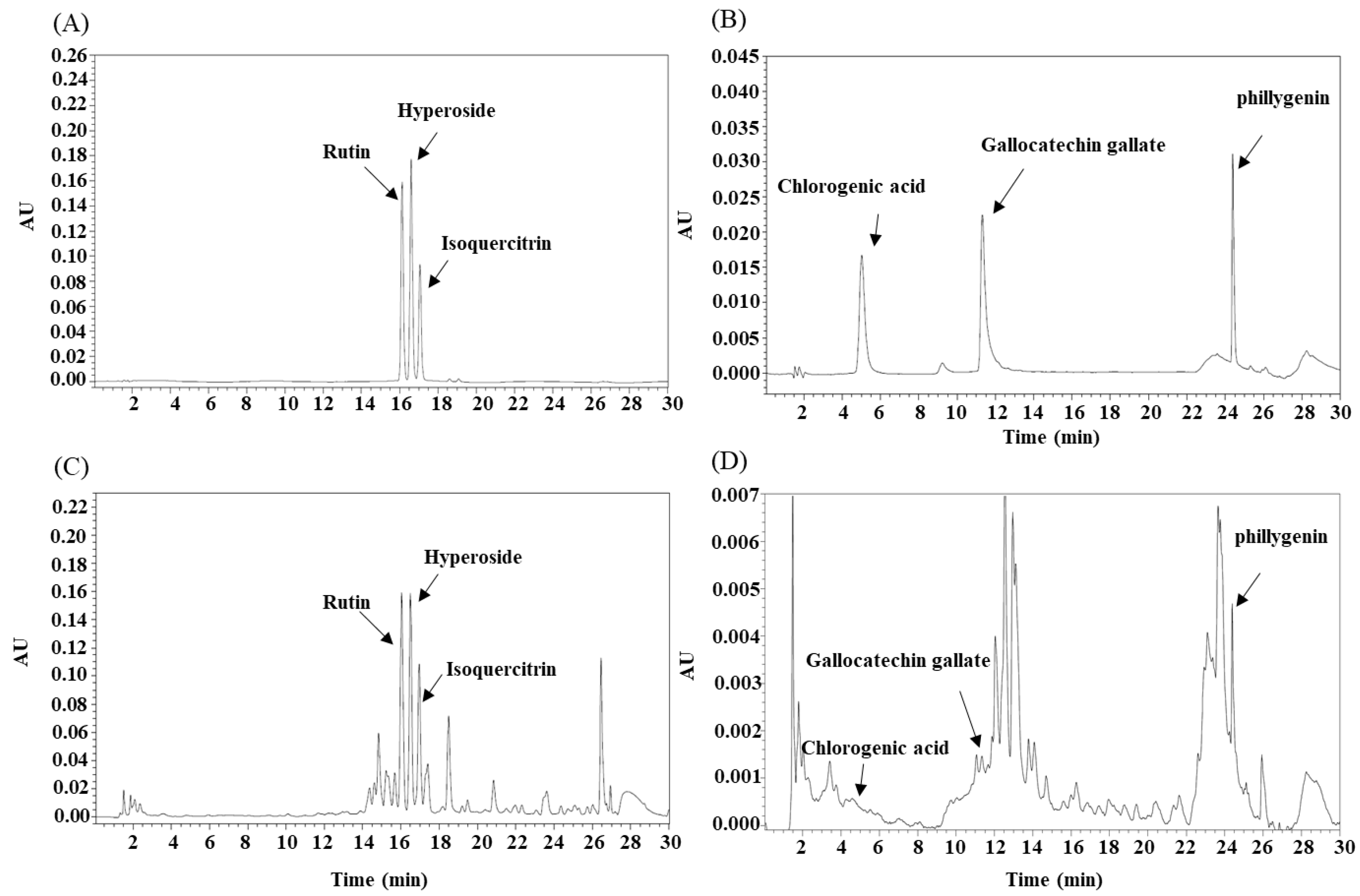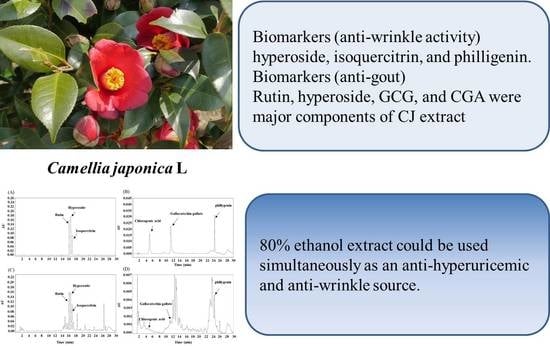Process Optimization Based on Biological Effects and Biomarker Contents of Camellia japonica L. for the Development of Anti-Hyperuricemic and Anti-Wrinkle Source
Abstract
1. Introduction
2. Results and Discussion
2.1. Extraction Yields of Extracts and Analysis of Bioactive Markers
2.2. Evaluation of Elastase Inhibitory Effects of CJ Extracts
2.3. Evaluation of Xanthine Oxidase Inhibitory Effects of CJ Extracts
3. Materials and Methods
3.1. Preparation of Extract
3.2. Constituents Profiling by High-Performance Liquid Chromatography (HPLC) Analysis
3.3. Determination of In Vitro Xanthine Oxidase (XO) Inhibitory Activity
3.4. Determination of Elastase Inhibitory Activity
4. Conclusions
Author Contributions
Funding
Data Availability Statement
Conflicts of Interest
References
- Onodera, K.; Hanashiro, K.; Yasumoto, T. Camellianoside, a novel antioxidant glycoside from the leaves of Camellia japonica. Biosci. Biotechnol. Biochem. 2006, 70, 1995–1998. [Google Scholar] [CrossRef] [PubMed]
- Piao, M.J.; Yoo, E.S.; Koh, Y.S.; Kang, H.K.; Kim, J.; Kim, Y.J.; Kang, H.H.; Hyun, J.W. Antioxidant effects of the ethanol extract from flower of Camellia japonica via scavenging of reactive oxygen species and induction of antioxidant enzymes. Int. J. Mol. Sci. 2011, 12, 2618–2630. [Google Scholar] [CrossRef] [PubMed]
- Zhang, Y.L.; Yin, C.P.; Kong, L.C.; Jiang, D.H. Extraction optimisation, purification and major antioxidant component of red pigments extracted from Camellia japonica. Food Chem. 2011, 129, 660–664. [Google Scholar] [CrossRef] [PubMed]
- Kim, S.; Jung, E.; Shin, S.; Kim, M.; Kim, Y.S.; Lee, J.; Park, D. Anti-inflammatory activity of Camellia japonica oil. BMB Rep. 2012, 45, 177–182. [Google Scholar] [CrossRef] [PubMed]
- Lee, H.S.; Choi, J.H.; Cui, L.; Li, Y.; Yang, J.M.; Yun, J.J.; Jung, J.E.; Choi, W.; Yoon, K.C. Anti-Inflammatory and Antioxidative Effects of Camellia japonica on Human Corneal Epithelial Cells and Experimental Dry Eye: In Vivo and In Vitro Study. Investig. Ophthalmol. Vis. Sci. 2017, 58, 1196–1207. [Google Scholar] [CrossRef]
- Heo, J. Donguibogam; Bubinmunhwasa: Seoul, Korea, 2002. [Google Scholar]
- Lee, S.Y.; Bae, C.S.; Seo, N.S.; Na, C.S.; Yoo, H.Y.; Oh, D.S.; Bae, M.S.; Kwon, M.S.; Cho, S.S.; Park, D.H. Camellia japonica oil suppressed asthma occurrence via GATA-3 & IL-4 pathway and its effective and major component is oleic acid. Phytomed. Int. J. Phytother. Phytopharm. 2019, 57, 84–94. [Google Scholar] [CrossRef]
- Yoon, I.S.; Park, D.H.; Kim, J.E.; Yoo, J.C.; Bae, M.S.; Oh, D.S.; Shim, J.H.; Choi, C.Y.; An, K.W.; Kim, E.I.; et al. Identification of the biologically active constituents of Camellia japonica leaf and anti-hyperuricemic effect in vitro and in vivo. Int. J. Mol. Med. 2017, 39, 1613–1620. [Google Scholar] [CrossRef] [PubMed]
- Ha, S.Y.; Jung, J.Y.; Yang, J.K. Camellia japonica Essential Oil Inhibits α-MSH-Induced Melanin Production and Tyrosinase Activity in B16F10 Melanoma Cells. Evid.-Based Complement. Altern. Med. Ecam 2021, 2021, 6328767. [Google Scholar] [CrossRef] [PubMed]
- Karadeniz, F.; Oh, J.H.; Kim, H.R.; Ko, J.; Kong, C.S. Camellioside A, isolated from Camellia japonica flowers, attenuates UVA-induced production of MMP-1 in HaCaT keratinocytes via suppression of MAPK activation. Exp. Ther. Med. 2021, 21, 16. [Google Scholar] [CrossRef] [PubMed]
- Kim, J.K.; Kim, C.R.; Lim, H.J.; Nam, S.H.; Joo, O.S.; Shin, D.H.; Shin, E.C. An optimized extraction technique for acetylcholinesterase inhibitors from the Camellia japonica seed cake by using response surface methodology. Biosci. Biotechnol. Biochem. 2014, 78, 1237–1241. [Google Scholar] [CrossRef]
- Kim, J.K.; Lim, H.J.; Kim, M.S.; Choi, S.J.; Kim, M.J.; Kim, C.R.; Shin, D.H.; Shin, E.C. Responsive Surface Methodology Optimizes Extraction Conditions of Industrial by-products, Camellia japonica Seed Cake. Pharmacogn. Mag. 2016, 12, 184–187. [Google Scholar] [CrossRef] [PubMed]
- Uddin, M.N.; Sharma, G.; Yang, J.L.; Choi, H.S.; Lim, S.I.; Kang, K.W.; Oh, W.K. Oleanane triterpenes as protein tyrosine phosphatase 1B (PTP1B) inhibitors from Camellia japonica. Phytochemistry 2014, 103, 99–106. [Google Scholar] [CrossRef] [PubMed]
- Thao, N.T.; Hung, T.M.; Lee, M.K.; Kim, J.C.; Min, B.S.; Bae, K. Triterpenoids from Camellia japonica and their cytotoxic activity. Chem. Pharm. Bull. 2010, 58, 121–124. [Google Scholar] [CrossRef] [PubMed]
- Idham, Z.; Putra, N.R.; Aziz, A.H.A.; Zaini, A.S.; Rasidek, N.A.M.; Mili, N.; Yunus, M.A.C. Improvement of extraction and stability of anthocyanins, the natural red pigment from roselle calyces using supercritical carbon dioxide extraction. J. CO2 Util. 2022, 56, 101839. [Google Scholar] [CrossRef]
- Putra, N.R.; Rizkiyah, D.N.; Idham, Z.; Veza, I.; Qomariyah, L.; Yunus, M.A.C. Optimization and modelling in flavonoid and phenolic compounds recovery from peanut skin by subcritical water. Biomass Convers. Biorefin. 2022, 30, 1–11. [Google Scholar] [CrossRef]
- Jeon, H.; Kim, J.Y.; Choi, J.K.; Han, E.; Song, C.L.; Lee, J.; Cho, Y.S. Effects of the Extracts from Fruit and Stem of Camellia japonica on Induced Pluripotency and Wound Healing. J. Clin. Med. 2018, 7, 449. [Google Scholar] [CrossRef]
- Oh, J.H.; Nam, G.B.; Karadeniz, F.; Kong, C.S.; Ko, J. Evaluation and enzyme-aided enhancement of anti-photoaging properties of Camellia japonica in UVA-irradiated keratinocytes. Z. Fur Naturforschung. C J. Biosci. 2022, 77, 287–296. [Google Scholar] [CrossRef] [PubMed]
- Shim, J.H.; Chae, J.I.; Cho, S.S. Identification and Extraction Optimization of Active Constituents in Citrus junos Seib ex TANAKA Peel and Its Biological Evaluation. Molecules 2019, 24, 680. [Google Scholar] [CrossRef] [PubMed]

| Sample | Extraction Yield (%, w/w) |
|---|---|
| Hot Water | 5.62 |
| 20% EtOH | 11.51 |
| 40% EtOH | 12.10 |
| 60% EtOH | 12.54 |
| 80% EtOH | 9.89 |
| 100% EtOH | 12.39 |
| Parameters | Conditions | |||||
|---|---|---|---|---|---|---|
| Column | Zorbax extended-C18(C18, 4.6 mm × 150 mm, 5 µm) | |||||
| Flow rate | 1 mL/min | |||||
| Injection volumn | 10 μL | |||||
| UV detection | 350 nm (for Rutin, Hyperoside, isoquercitrin)290 nm (for chlorogenic acid, gallocatechin gallate, phillygenin) | |||||
| Run time | 30 min | |||||
| Gradient | (For Rutin, Hyperoside, isoquercitrin) | (For chlorogenic acid, gallocatechin gallate, phillygenin) | ||||
| Time (min) | % A 1 | % B 2 | Time (min) | % A 1 | % B 2 | |
| 0 | 10 | 90 | 0 | 10 | 90 | |
| 5 | 10 | 90 | 6 | 10 | 90 | |
| 24 | 26 | 74 | 10 | 20 | 80 | |
| 25 | 100 | 0 | 20 | 25 | 75 | |
| 28 | 100 | 0 | 25 | 100 | 0 | |
| 29 | 10 | 90 | 28 | 10 | 90 | |
| Extract | Chlorogenic Acid (%, w/w) | Gallocatechin Gallate (%, w/w) | Hyperoside (%, w/w) | Isoquercitrin (%, w/w) | Phillygenin (%, w/w) | Rutin (%, w/w) | Total (%, w/w) |
|---|---|---|---|---|---|---|---|
| Hot Water | - | 0.05 ± 0.004 | 0.21 ± 0.005 | 0.13 ± 0.004 | 0.14 ± 0.007 | 0.44 ± 0.010 | 0.97 |
| 20% ETOH | 0.02 ± 0.001 | 0.04 ± 0.002 | 0.11 ± 0.001 | 0.08 ± 0.001 | 0.11 ± 0.011 | 0.40 ± 0.001 | 0.76 |
| 40% ETOH | 0.02 ± 0.002 | 0.01 ± 0.001 | 0.24 ± 0.004 | 0.16 ± 0.004 | 0.07 ± 0.002 | 0.51 ± 0.005 | 1.17 |
| 60% ETOH | 0.02 ± 0.001 | 0.01 ± 0.001 | 0.40 ± 0.002 | 0.25 ± 0.003 | 0.12 ± 0.001 | 0.67 ± 0.003 | 1.47 |
| 80% ETOH | - | 0.03 ± 0.001 | 0.65 ± 0.051 | 0.46 ± 0.042 | 0.12 ± 0.007 | 0.94 ± 0.078 | 2.20 |
| 100% ETOH | - | 0.02 ± 0.001 | 0.19 ± 0.002 | 0.13 ± 0.001 | 0.12 ± 0.006 | 0.35 ± 0.007 | 0.81 |
| Sample (500 µg/mL) | Elastase Inhibition (%) | Smaple (100 µg/mL) | Elastase Inhibition (%) |
|---|---|---|---|
| PPRM 1 | 81.65± 3.888 | PPRM 1 | 57.13 ± 3.502 |
| Hot Water | 40.75± 1.840 | CGA 2 | 3.45 ± 0.212 |
| 20% ETOH | 42.66 ± 2.086 | GCG 3 | 4.57 ± 0.105 |
| 40% ETOH | 47.63 ± 0.457 | Hypeorside | 31.74 ± 0.571 |
| 60% ETOH | 49.24 ± 0.234 | Isoquercitrin | 17.98 ± 1.496 |
| 80% ETOH | 62.54 ± 0.742 | Phillygenin | 13.70 ± 0.249 |
| 100% ETOH | 57.57 ± 1.638 | Rutin | 0.45 ± 0.003 |
| Sample | Elastase inhibition (%) | ||
| PPRM 1 | 80.80 ± 0.937 | ||
| Mixture of Constituent | 28.92 ± 0.836 | ||
| 80% EtOH | 60.66 ± 4.255 | ||
| Sample (500 µg/mL) | Xanthine Oxidase (%) | Sample (100 µg/mL) | Xanthine Oxidase (%) |
|---|---|---|---|
| Control | 100.00 ± 3.724 | Control | 100.00 ± 3.724 |
| Allopurinol 1 | 52.12 ± 2.099 | Allopurinol 1 | 52.12 ± 2.099 |
| Hot Water | 92.58 ± 1.071 | CGA 2 | 87.12 ± 1.071 |
| 20% ETOH | 97.07 ± 1.948 | GCG 3 | 81.52 ± 0.350 |
| 40% ETOH | 94.75 ± 1.525 | Hypeorside | 69.80 ± 1.669 |
| 60% ETOH | 87.47 ± 3.338 | Isoquercitrin | 93.54 ± 3.837 |
| 80% ETOH | 84.44 ± 2.816 | Phillygenin | 92.02 ± 2.274 |
| 100% ETOH | 93.94 ± 5.327 | Rutin | 60.76 ± 3.214 |
| Sample | Xanthine oxidase (%) | ||
| Control | 100.00 ± 3.724 | ||
| Allopurinol 1 | 52.12 ± 2.099 | ||
| Mixture of Constituent | 87.37 ± 0.926 | ||
| 80% EtOH | 84.44 ± 2.816 | ||
Publisher’s Note: MDPI stays neutral with regard to jurisdictional claims in published maps and institutional affiliations. |
© 2022 by the authors. Licensee MDPI, Basel, Switzerland. This article is an open access article distributed under the terms and conditions of the Creative Commons Attribution (CC BY) license (https://creativecommons.org/licenses/by/4.0/).
Share and Cite
Song, S.-Y.; Park, D.-H.; An, K.-W.; Cho, S.-S. Process Optimization Based on Biological Effects and Biomarker Contents of Camellia japonica L. for the Development of Anti-Hyperuricemic and Anti-Wrinkle Source. Separations 2022, 9, 281. https://doi.org/10.3390/separations9100281
Song S-Y, Park D-H, An K-W, Cho S-S. Process Optimization Based on Biological Effects and Biomarker Contents of Camellia japonica L. for the Development of Anti-Hyperuricemic and Anti-Wrinkle Source. Separations. 2022; 9(10):281. https://doi.org/10.3390/separations9100281
Chicago/Turabian StyleSong, Seung-Yub, Dae-Hun Park, Ki-Wan An, and Seung-Sik Cho. 2022. "Process Optimization Based on Biological Effects and Biomarker Contents of Camellia japonica L. for the Development of Anti-Hyperuricemic and Anti-Wrinkle Source" Separations 9, no. 10: 281. https://doi.org/10.3390/separations9100281
APA StyleSong, S.-Y., Park, D.-H., An, K.-W., & Cho, S.-S. (2022). Process Optimization Based on Biological Effects and Biomarker Contents of Camellia japonica L. for the Development of Anti-Hyperuricemic and Anti-Wrinkle Source. Separations, 9(10), 281. https://doi.org/10.3390/separations9100281











